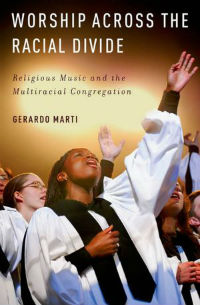Editor’s note: This is the first of two posts engaging with “Worship across the Racial Divide: Religious Music and the Multiracial Congregation,” by Gerardo Marti. Look for Joy Moore’s post next week.
There is a growing consensus among church leaders that a mono-racial church in an increasingly multiracial culture is problematic, if not outright embarrassing. While few congregations in the United States can claim much in the way of racial or ethnic diversity, an increasing number of Christians can at least agree that the homogeneity of the past -- and present -- is something to repent of and move beyond.
embarrassing. While few congregations in the United States can claim much in the way of racial or ethnic diversity, an increasing number of Christians can at least agree that the homogeneity of the past -- and present -- is something to repent of and move beyond.
As the co-pastor of a small Presbyterian congregation that is attempting to be more diverse, I can tell you, there is no paint-by-numbers solution. And while Gerardo Marti’s research in his new book, “Worship across the Racial Divide: Religious Music and the Multiracial Congregation” suggests as much, it also offers some promising pathways. He’s discovered that within the worshipping life of congregations, it’s not so much the music itself, but the act of making it that has the power to bring people together.
Marti shows that worship music does play a significant role in creating congregational diversity, but not in the ways most people assume. Through interviews with pastors, musicians and worshippers, he pays less attention to the sounds and styles of worship music, and instead concentrates more on “the complex of practices of the worshipping community in the production and absorption of music.” The power of music and worship to bring change seems to be less in what Marti hears (the acoustics of music) and more on what he sees (the underlying relationships and social structures behind the music).
It’s not the music itself, but opportunities for the production of music that allow interracial and ethnic bonding to occur. Friendships form when people gather to plan, practice and perform the music of the church.
But friendships take time and practice. Marti finds that a defining characteristic of successfully diverse congregations is the prominent, weekly inclusion of visible, racial and ethnic diversity in worship services. Again, the music style doesn’t seem to matter so much as long as there is a diversity of folks “up front” leading worship. This creates a symbolic environment of “racialized ritual inclusion” that over time announces to the congregation there is room and desire for diversity throughout the church. The point here is that visible and consistent diversity in worship leadership matters for the culture of the congregation.
Marti’s observations resonate with my own experience at Durham Presbyterian Church, a congregation becoming younger and more diverse. We've spent untold hours planning worship and music, trusting the right songs and styles would provide a welcome home for a diversity of people, only to find it is the depth and diversity of friendships engaged in leading worship that is slowly moving our church toward the vision of reflecting the diversity of Durham.
One line in Marti’s book startled me, despite its painful obviousness: “Scholars who study diverse congregations seem to agree that if we left congregations to their own desires, congregations would remain almost wholly homogenous.” Change requires active obedience grounded in a deep and abiding desire for a church that visibly reflects the unity we’ve been given in Jesus. The change won’t come without pain and conflict. Thankfully, we live in a time of increasing clarity: racially and culturally homogenous congregations compromise our witness to and experience of the saving work of Jesus.
Marti’s book is a must read for pastors and other church leaders struggling to understand what reconciliation looks like in their contexts. He helps churches navigate the social complexities of multiracial worship and provides insight into how successful multiracial churches function.
I can only pray these hopeful congregations are a foretaste of God’s new work in the world, a sign of healing for the schism in the soul of the American church.











